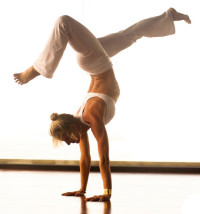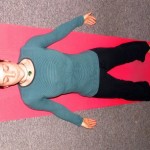by Kara-Leah Grant
This came up in conversation this week – a new teacher expressing a fear that her yoga sequences weren’t interesting enough and that she was going to be boring her students. She wanted to know how to make her sequences more interesting.
However, there is a fallacy of logic here. The teacher has a fear arising – that of boring her students. Her approach to working with that fear is to ensure that the external circumstance triggering the fear is removed – bored students.
This leaves the fear intact, unexplored, unconscious and ready to pop up another time.
There is a different way of working with fear, one that has nothing at all to do with designing interesting yoga sequences and everything to do with self-inquiry.
And that is the heart of yoga – self-inquiry. Turning one’s gaze inwards and inspecting all those thoughts, feelings, beliefs, assumptions, sensations and fears that arise and asking;
What is that?
What is that?
What is that?
Questions are the key – assume you know nothing, and instead ask everything. Don’t seek to answer the questions either, let them drop into spaciousness within and watch to see what arises.
I asked this new teacher:
Do you think Pattabhis Jois was afraid students would get bored of the Ashtanga sequences?
Was Krishnamacharya afraid Pattabhis Jois would get bored of that sequence?
Do Ashtangis get bored of the Ashtanga sequence?
What does it mean to ‘get bored’?
Who is ‘getting bored’?
What does ‘that which gets bored’, desire?
Why does ‘that which get bored’, desire that?
What is one looking for when one is bored?
Of course, I didn’t ask these questions all in a row, they were parsed out gently, over a flow of conversation which took most of an hour.
Not all of these questions have answers. Or rather, they don’t have ‘right’ answers.
Instead, the questions themselves open up space within and through that internal space we may begin to perceive life in a different way.
There’s another way to work with this query as well – these questions focused mainly on the nature of boredom and what it points to in our quest for self-realisation.
You can also inquire directly into the fear:
Where does the fear come from?
What desire, or attachment gives rise to the fear?
What would need to be let go of, so that the fear no longer exists?
Exploring the fear in this way helps to determine it’s relationship to attachment or desire. Once that relationship is established, one can begin to work with that attachment or desire.
In this case, there is a desire to be liked, to be a good teacher, to have students come to one’s classes.
However, this desire can conflict with another desire – that to teach yoga. This is a conundrum in our modern yoga world. Sometimes, the best ways to teach yoga don’t lead to the biggest class sizes, or the most students, or being liked and loved by one’s students.
Conversely, sometimes teaching in a way that panders to the students’ egos and our ego’s love of constant stimulation and distraction, does lead to bigger classes and more students and being liked, loved and followed by students.
Why is this? Because yoga is a hard path and facing the truth of oneself is not easy. It’s far more enjoyable to go to a fun asana class that allows one to constantly skirt around the underlying samskaras and issues without delving into them at all.
And this is why it’s crucial that we as teachers are on the path of yoga – a path of self-inquiry leading to self-realisation – rather than just the path of asana, which is all about a flexible, open body leading to more and more cool postures.
The nature of yoga and how it is transmitted means that whatever ignorance we as yoga teachers are experiencing, whatever samskaras we’re experiencing, whatever unconscious fears or beliefs we haven’t yet examined… these all get transmitted when we teach yoga. Or rather, there is the potential for them to be transmitted.
If we’re designing fancy sequences because we’re afraid that our students will get bored otherwise… what are we transmitting when we teach?
What are we teaching our students on an unconscious level?
However, if we notice that we’re afraid our students will get bored, and we examine what is happening within us when this fear arises, then what happens? We begin to clear some of our own samskaras and fears. What happens now when we teach? What are we possibly able to see in our students now as we teach?
This is the difference between teaching asana and teaching yoga.
One is about teaching a fun class, pleasing the students and getting good at communicating the nuances of postures.
The other is about understanding the process of self-inquiry and being able to direct it first in oneself, and then in others while they are doing postures in class.
In the hands of a skilled yoga teacher, the postures become a tool that reveal the ego structure of the student.
In the hands of an unskilled yoga teacher, the postures can become a tool which reinforce the ego structure of the student.
In the end, teachers will only ever teach what they know. Seek out teachers who know themselves, so they can teach you how to know yourself. Be wary of teachers that only know postures.
And if you’re a teacher, make self-inquiry the heart of your yoga practice, whether it’s happening through asana, pranayama, meditation, chanting, or svadhyaya (self-study).
The clearer you are, the better your teaching will be, regardless of how fancy your sequences are.
****
Note: Intelligent, energetically aligned sequencing is an art in and of itself, and one that is also to be revered. However, this kind of sequencing, while it may look ‘fancy’ is not designed to titillate the student but to open the body in a specific way. The best intelligent, energetically aligned and creative sequencing I have ever experienced is that of Shiva Rea’s.



Hi Kara-Leah, I’ve been reading a lot of your articles and watching a lot of your video blogs and really appreciate your words. For a long time I’ve been pondering yoga and recently I’ve been through some tough times, and through these times I’ve been learning a lot of the things you have talked about.
My real question is in your yoga books do you teach the inner works along with the body and postures? I live in Canada so I’d rather try and teach myself your style rather hope around from teacher to teacher learning nothing but postures and just the physical side of yoga.
Hey Leo,
My books don’t contain any postures at all – it’s all about the psychological process that one goes on when hitting the yoga mat on a daily basis. So yes – it’s all inner works really.
I always love the predictability of a class and teacher well known. It gives more time to concentrate on breath control an improving alignment in the posture. The teacher delivery is important to me.
I teach beginners, and only have them once a week, so I think repetition is important to them again, to concentrate on the breath and posture. I don’t even try too much flow without first strengthening the “ how to get there” transitions.